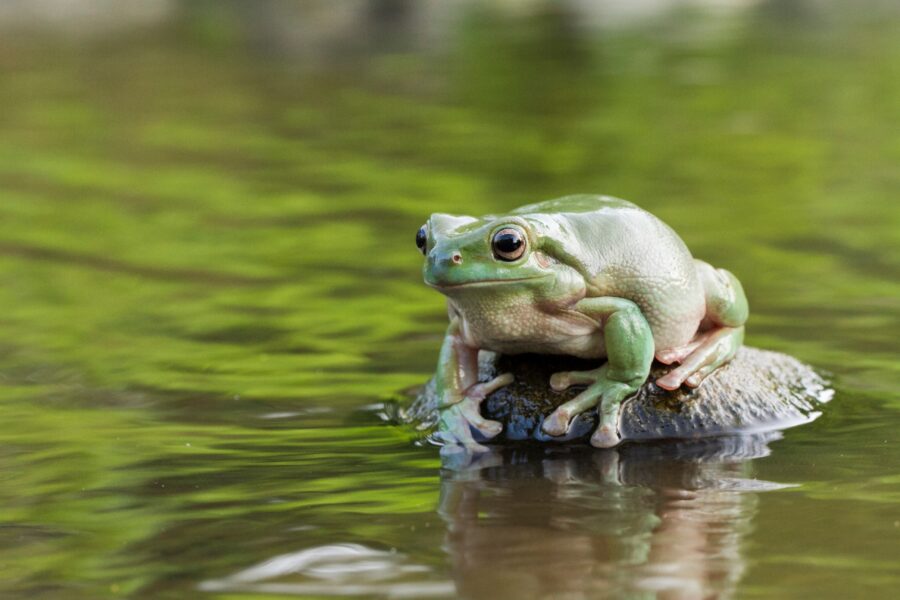Volunteer research with manta rays
JUST PAST SUNRISE, I stand, bleary-eyed, on the bow of Sail Ningaloo’s luxury catamaran Shore Thing, scouting for reef manta rays while waiting for coffee to brew.
When caffeinated aromas begin swimming through the still-cool salty air, I steal a final glance towards the slightly stirred waters of Bateman’s Bay at Ningaloo Reef, WA, already turning to go.
A flash of white catches my eye as something 100m away launches itself above the ocean’s veil.
“Manta ray!” I yell. “Quick …it’s breaching!”
Within minutes, six of us, immediately wide awake, are in the tender, fins and snorkel masks on, underwater cameras ready. Shore Thing’s co-owner and captain, Luke Riley, motors us towards several sets of black fins, which slice the water as the creatures skim just beneath the surface, feasting on planktonic crustaceans, too tiny to see.
When we’re within several metres of the action, Luke cuts the motor. Suppressing delighted squeals, we slide into their underwater dining room, hoping our arrival doesn’t inspire them to seek a meal elsewhere.
The multi-day return journey from Coral Bay, Western Australia, has already delivered sightings of the astonishingly beautiful filter-feeding rays. At a place called North Reef, several mantas were performing continuous backwards, mid-water somersaults. Mantas use this efficient feeding technique, known as barrel rolling, when swarms of plankton are concentrated vertically in the water column.
Others were skimming close to the bottom of the 12-15m water column, their wide, wing-like pectoral fins ever-so-gently propelling them forward as their celaphic lobes – fleshy-looking flaps on either side of the head – helped funnel food into their enormous and almost rectangular terminal mouths.
Participate in manta ray research
We passengers observe their activity using a mask and snorkel, mesmerised and breathless from attempting to keep up with their seemingly effortless but remarkably swift ‘flying’ motions. And a few of us exacerbate our exhaustion by free diving towards the ocean floor, trying to capture images of the skimming mantas’ underbellies before racing to the surface, desperate for air.
Why test our lungs when the surface view of mantas is already extraordinary?
In addition to experiencing the wonders of Ningaloo, Australia’s largest fringing coral reef, we’re here to assist Frazer McGregor, a PhD candidate at Murdoch University’s Coral Bay Research Station, as he gathers data on Ningaloo’s resident and transitory manta population.
Until fairly recently, only one species of manta ray was formally recognised. In 2008, Andrea Marshall, a marine biologist conducting her PhD research in Mozambique, formally categorised and described two separate species, both of which have global distribution and often coexist.
Prior to Andrea’s results being published, reef manta rays (Manta alfredi), which have wingspans of up to 4.5m, and giant manta rays (Manta birostris), with wingspans of up to 8m, were grouped taxonomically as the same species.
Both species are found in tropical and subtropical waters around the world, migrating great distances and aggregating to feed or be groomed at places known as cleaning stations, where tiny fish remove parasites from larger fish.
However, as giant mantas prefer deeper waters, few appear within Ningaloo Marine Park. Here, we’re much more likely to see reef mantas.
Manta ray life largely unknown
“Prior to 2003, no one was studying mantas in Ningaloo,” Frazer tells us. “So we had no baseline of data for Ningaloo Marine Park. We didn’t know how many mantas there were, why they came here, how long they were here, or where they bred – which made it very hard for the government agencies to change legislation.”
“The Western Australia Department of Environment and Conservation do aerial surveys to look at overall numbers of all megafauna. If you do a plane flight from one end of Ningaloo to the other every year [in autumn], you’ll find lots of mantas. But what about the rest of the year and what about localised areas such as Bateman Bay where we have resident animals? We became concerned that maybe these resident animals were being affected by tourism.”
Frazer is working with local tour companies to take daily photos of the graceful creatures. He aims to find out more about the reef manta ray population – “what they’re doing, when they’re doing it” – he says, with the view of revising management practices for the species.
One of the outcomes Frazer would like see is a compulsory code of conduct for manta swimming tours, instead of the voluntary and often-discarded code that currently exists. He also hopes his research will encourage state and federal governments to elevate protection status throughout Australian waters.
More protection needed for manta rays
Listed as Vulnerable to extinction on the International Union for the Conservation of Nature’s (IUCN) Red List of Threatened Species, manta rays are susceptible to incidental fishing (bycatch) and are targeted for their gill rakers, which are used in health tonics and sold primarily in Chinese medicine markets.
However, in Australia they are only protected in Ningaloo Marine Park and a few other small marine parks and reserves.
Frazer points out that, at the moment, he could legally “go into Exmouth Gulf with a commercial fisherman, spear a manta, and sell parts of it in one of the many Chinese markets in any Australian capital city.”
Manta rays’ unique markings
Like leopard with unique spots, manta rays have unique marking on their bellies that researchers can use to identify individuals. So far, Frazer has used belly pictures to identify nearly 600 manta rays and track how many times they’ve been spotted.
Everyone can help with the research, Frazer says, by photographing the image pattern between the gills on the manta’s belly, as well as any scarring. Female manta rays, for example, often exhibit scarring on their left pectoral wingtip, which males bite during the mating process.
It’s a task we enthusiastically get into. After taking as many photos as we can, we gather on Shore Thing’s back deck, reviewing our images and checking whether the mantas’ sex, scarring, and underbelly patterns match any individuals in Frazer’s database.
Captain Luke records the approximate time we saw each manta as well as location, behaviour, and presence of other mantas with it. Frazer adds this information to his database for scientific analysis of demographics, population sizes, and stability, and it also goes into a regional and global database that investigates movements between populations.
Falling in love with mantas
Back in the water, I spy on the mantas’ Bateman Bay breakfast frenzy. The elegant rays fly around me, occasionally soaring close and meeting my eyes with a calm, inquisitive expression of wonder.
Frazer told us that we’d “fall in love with the mantas very quickly”, especially if we had a one-on-one experience.
He was so right.
RELATED STORIES




